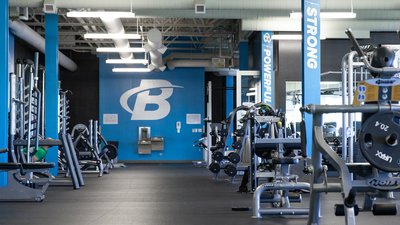It can happen to the best of us. We train as hard as we can, push our bodies to the limits, and those nagging aches and pains always somehow manage to turn into an injury. What to do? Most of us will probably want to "gut it out" and continue training, but what about the consequences of not letting an injury take the time to heal?
One lesson I've learned over the years is that it is OK to train through pain, but it is never OK to train through a serious injury. So if you are injured, that is something you need to take care of right away before it turns into a chronic problem or gets worse.
Weight training is a very demanding sport, and pushing, pulling, and straining against heavy iron using all of your strength can often be quite dangerous. Of course we all want to train hard and make significant gains, but at what cost?
Without risk there is no reward, and with hard training comes the risk of injury and missing significant time away from the gym.

"Weight training is a very demanding sport, and pushing, pulling, and straining against heavy iron using all of your strength can often be quite dangerous."
If you have an injury, you'll probably want to do whatever you can to make sure you don't miss a workout, but this can be a catch-22. If you continue training, or return to training too soon, you can increase your chance of developing a chronic injury that may never fully go away.
On the other hand, if you take too much time off, you will lose much of what you worked so hard to build.
If you're like me, you won't want to miss any time at all because of an injury, so here are a few tips that will help you effectively train with an injury so that you won't miss significant time away from the gym.
1. Nutrition
This is number one on my list, not only because nutrition is often underrated and overlooked, but also because it's likely the most important factor in injury recovery.
Healing from an injury can take weeks or even months (healing time can vary from person to person), but you can dramatically accelerate the healing process by getting adequate nutrition and maintaining a healthy lifestyle.
Healing is largely dependent on blood supply, and the stronger the blood supply, the faster you can heal because blood supplies the injured area with important oxygen and nutrients which help the injury heal.
Certain foods can promote inflammation within the body, while others have an anti-inflammatory effect.
Avoid inflammation-promoting foods such as fried foods, processed white flour, eggplant, cayenne, tomatoes, potatoes, and hot peppers, and eat more foods that are high in omega-3 fatty acids.
Be sure to drink plenty of fresh juices made from fresh, organic, raw veggies, because raw veggies are high in important enzymes and vitamins that can speed up the healing process.
Garlic, radishes, and beets are especially helpful. You can also mix in a bit of fresh ginger; ginger has powerful anti-inflammatory properties and helps reduce pain and soreness.
To create an optimal healing environment and get back on your feet quicker, be sure to eat 8-10 servings of fruit and vegetables daily.
Important nutrients that aid recovery:
- Multivitamin: Very important. Helps prevent vitamin and mineral deficiencies. Aids tissue repair.
- Zinc: Important in tissue repair.
- Vitamin C with Bioflavonoids: An important antioxidant which helps tissue repair and growth.
- Manganese: Strengthens wounded tendons and ligaments.
- BCAA's: Help promote the healing of muscle tissue, bones, and skin.
- EFA's (essential fatty acids): Speed up recovery and promotes cellular health.
- Vitamin B Complex: Helps reduce injury related stress.
- Glucosamine Sulfate: Helps strengthen and form tendons, cartilage, ligaments, and joint fluid.
- Calcium: Helps repair connective tissue.
- Silica: Important for calcium absorption and connective tissue repair.
2. Know When To Tough It Out
It is very important to know the difference between a real injury and pain. During a workout, you may tweak something and experience pain.
Your initial reaction might be, "Ouch ... but OK, I'm not bleeding, let's tough this out." If you have pain, stop working out right there and evaluate your symptoms to check the severity. Don't just try to walk it out and hope for the best.
Of course we all want to be tough and gut it out, but the consequences for continuing to train and not taking enough time off to heal can be severe. Most of the time, it is a good idea to just stop and heal up before training again.

"Small, nagging aches and pains are all part of training and you should definitely tough it out but if you have a legitimate injury, it is always best to stop and evaluate."
Of course, small, nagging aches and pains are all part of training and you should definitely tough it out and work through those types of situations, especially if you are in contest prep, but if you have a legitimate injury, it is always best to stop and evaluate.
The most obvious symptom of an injury is pain. So if you experience severe pain, stop or take a break until the pain is manageable enough to continue. If the pain refuses to go away, just stop and see a doctor.
There is a large grey area between what is a "real injury" and what is just a nagging pain, and only a doctor can truly determine which one you have. I always say that, when hurt, get checked out by a doctor.
Injury Types
So how do you know if you have a real injury? Generally there are three types of injuries: acute, sub-acute, and chronic.
An acute injury occurs immediately, and a few examples are spraining an ankle, tearing a muscle, or breaking a leg. Poor nutrition, failure to warm up, bad lifting technique, and even bad luck can be contributing factors. These injuries are usually serious, and hard training is not recommended.
A sub-acute injury is one that builds up over months or years. Examples are muscle strains and various wear and tear injuries that progressively get worse.
These can be the most frustrating injuries of all because although you can still train, you can't train at your maximum intensity level and performance is hampered.
Chronic injuries can be devastating. Examples are joint injuries such as rotator cuff injury, shoulder bursitis, or tendonitis.
These sorts of injuries must be handled with caution because just one tweak and you could end up in the operating room. Be sure to take good care of a chronic injury and follow your doctor's instructions to the tee.
Keep in mind that recovering from injury becomes much harder as you get older.
Older muscle fibers, tendons, and ligaments need more time to recover. If you have a nagging injury, remember that age plays a very important role in determining when it is safe to return to normal activity.
3. Use The RICE Method
If you have an acute injury you will probably experience mild to severe swelling around the site of the injury. This is due to the fact that damaged tissue usually swells. This swelling can cause pain, loss of motion, and frustration because you won't be able to effectively use that area.
RICE (Rest, Ice, Compression, and Elevation), is a great way to treat that injury, reduce swelling quickly, alleviate pain, protect the injured area, and accelerate the healing process.
Ice: Using ice is still the best way to treat an acute sports injury. Ice helps reduce swelling and provides temporary short-term pain relief by reducing blood flow to the injured area. I recommend using ice post-workout for 15 minutes at a time for up to an hour. 15 minutes on, then 15 minutes off.
Tip: Never use heat on an acute injury. Heat dilates blood vessels, accelerates blood flow, and increases swelling, which can make an injury much worse. Ice reduces blood flow to tissue and by doing so, reduces swelling. Use ice instead!
Compression: Just like ice, compression can help reduce swelling. Getting rid of swelling is important because when swelling occurs, the injury can take longer to heal. I recommend using an ACE bandage wrap plus ice because this combo is much more effective at reducing swelling than by just using ice only.
Elevation: This is another useful tactic to keep swelling in check, and it works best when the injured area is raised above your heart. For example, if you have a sprained ankle, prop it up on a few pillows while you lie down. Most injuries can be effectively treated using RICE, but if you have a more serious injury, you may need to see a doctor, especially if you experience any of the following :
- Three or four weeks go by and you have not healed, or still have persistent pain.
- You can't move the injured part.
- You experience radiating pain.
- You have a joint injury that causes swelling.
- You feel tingling or numbness in the injured area.
Remember, if you are in pain, the most important thing to do is get your injury looked at by a doctor.
4. Train With Lighter Weights And Higher Reps
If you are training through an injury and are directly working the affected area, I recommend using lighter weights and higher repetitions.
Don't jerk or throw the weight around; instead, use slower, more concentrated reps, and feel the target muscle so you don't overstep the limitations of the injury and aggravate it.
By performing frequent, low-intensity exercises and higher reps, you can activate the injured area and accelerate the healing process by getting the muscles moving, especially if you do it early on after the injury.

"If you are training through an injury and are directly working the affected area, I recommend using lighter weights and higher repetitions."
5. Be Creative
Just because your knee hurts, for example, there is no reason you can't find other ways to work out and stay in shape while you are doing rehab or nursing that knee injury.
As a former athlete, I have done my fair share of training through injuries, and I always try to come up with new and creative ways to work muscle groups during an injury period.
The important thing is to protect the injured area until it is fully healed, while training the rest of your body as normal. A good way to do this is by doing circuit training.
Short circuit workouts will also allow you to stay fit and maintain your conditioning level while you allow the injured area to rest and heal.
I have had shoulder problems in the past, so when my shoulder gives me trouble I may try to do a circuit where I don't directly target the shoulders at all, but place more emphasis on my lower body. This way I am able to maintain strength in my non-injured muscles and stay somewhat on track.
6. Work Around the Pain
Unless the injury is serious, I always try to find a way to work around it. For example, if you have an elbow problem, you may want to try using alternative movements instead of normal movements.
Try changing your grip on the weight, or see if alternative exercises for the same muscle group cause pain.
7. Use Proper Form
Training injuries can occur for a variety of reasons, but the most common reason is a failure to use proper form when lifting.
Incorrect technique can place your muscles, tendons, and joints in awkward positions and increase the likelihood of a freak injury such as a muscle or tendon tear. If you are already in pain, bad form will increase your injury risk even more.
The human body has very specific biomechanical pathways that we must adhere to if we want to remain injury-free, and technical proficiency when lifting can dramatically reduce your risk of injury. Keep in mind that your limbs can only move in certain ways, and contorting, jerking, or twisting, to lift a weight can put you at extreme risk.
8. Warm Up Properly
The saying goes: An ounce of prevention is worth a pound of cure. The same logic applies here. I see many people in my gym walk in and go straight into their workout with little to no warm-up at all. Even though this is an easy habit to fall into, it is a risky one. A proper warm-up is important.
If you quickly flex or place tension on a cold muscle, you increase your risk of injury to that muscle. But if you gradually raise the temperature of the muscle and then slowly stretch it out with static stretching you will help relax and elongate the muscle, and place it in an injury-resistant state. So be sure to stretch and warm up before you train!
As an added bonus, stretching can also help you build more muscle because it can help promote circulation and helps increase fascia elasticity.
Tip: For a quick 5-minute warm-up that will get your entire body warm, try 20 quick, easy, nonstop reps of this workout:

BodyFit
$6.99/month- 2,500+ expert-created single workouts
- 3,500+ how-to exercise videos
- Detailed workout instruction
- Step-by-step workout tips
- Training at gym or at home
- Access to Workout Plans
- Access to Bodyfit App
- Store Discounts
Already have a Bodybuilding.com account with BodyFit? Sign In

What comes with BodyFit?

- Instructional Videos
Don't risk doing a workout improperly! Avoid injury and keep your form in check with in-depth instructional videos.

- How-to Images
View our enormous library of workout photos and see exactly how each exercise should be done before you give it a shot.

- Step-by-Step Instructions
Quickly read through our step-by-step directions to ensure you're doing each workout correctly the first time, every time.
9. Stay Positive
Let's face it; injuries can be a total bummer, but research suggests that maintaining a positive, upbeat attitude when injured or rehabbing can help speed up the healing process.
So instead of looking at your injury as bad luck, or as an obstacle, think of it as an opportunity to work on and improve a weaker body part while the injured parts heal up.
It always pays to look on the bright side, so even if you are injured, stay positive and you can still make progress, even while injured.
10. Rehab And Prevention
I cannot understate the importance of proper injury treatment and rest, but once your pain starts to go away you'll probably think about jumping back into hardcore training right away. This is a very common mistake many athletes make post-injury.
The primary concern here is reinjury. When you miss significant time from the gym due to injury, the rapid atrophy and degeneration of your muscle tissue that takes place can put you at high risk for re-injury once you start training again.
If in fact you do jump the gun and reinjure yourself, you'll have to endure the entire painstaking rest and treatment process all over again. Not only is this cycle frustrating, but it is usually preventable.
If you have a serious injury, always get the approval and recommendation of your doctor before returning to the gym, because developing a long term injury just isn't worth it. If you are in serious pain, put your training on hold and see a doctor.
I know that many people hate going to the doctor because they believe that their injury may miraculously disappear the next day, but resting when injured is critical because you protect the injured tendon, ligament, and muscle from further injury and damage.
Be sure to follow your doctor's recommendation for when you can return to the gym, how hard to push yourself, what types of exercises are best, and the type of rehab you should be doing.
Don't try to avoid a nagging injury. It is far better to miss two or three days now than to be forced to take two or three months off down the road.
So there you have it: all the need-to-know information about training with an injury. Make sure you apply these tips so an injury doesn't get you down!




